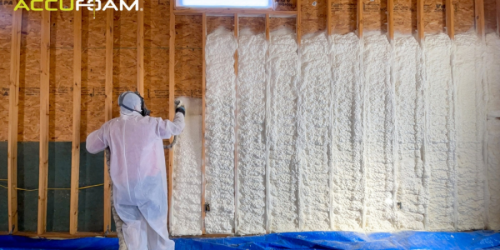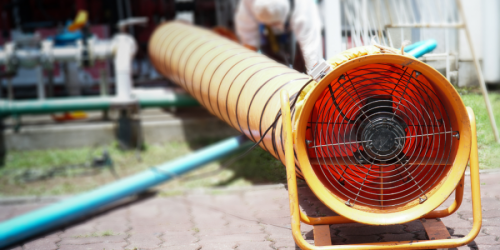Q&A Forums
oxygen barrier? Post New Topic | Post Reply
| Author | Comments |
|---|---|
|
steven argus
Posted: Nov 01, 2010 10:47 PM
|
oxygen barrier?
Is 3 inches of closed cell an oxygen barrier? We have been spraying PEX tubing in underground ditches for out door wood boilers. The PEX has an O2 barrier built in but it is more expensive than standard PEX. Not tryng to cut corners here, just trying to keep more money in my pocket. Thanks.P.S. Does underground foam need an ignition barrier or a thermal barrier? |
|
mason
Posted: Nov 02, 2010 08:12 AM
|
Closed cell SPF is not a gas impermeable material. Air can gradually infiltrate into the foam, that is why the foam loses R value over time. For example in the first 6 months, closed cell SPF loses approximately 5-10% of its initial R value. After that it stays relatively stable. The thicker the application the longer it takes the outside air to infiltrate into the foam. 2nd question, no, Foam plastic does not require a thermal or ignition barrier when buried in the ground. It is pretty hard to catch dirt on fire. Studies conducted by Dupont in the 60s and 70s demonstrate that foam buried in the ground for up to 10 years retains its physical properties with very little critter damage. However, if the water table is high, the foam might become saturated due to hydrostatic pressure and/or water vapor drive. If this is the case the foam should be covered with a waterproofing coating. |
|
steven argus
Posted: Nov 02, 2010 03:49 PM
|
Sorry Mason, the 2nd question was a joke- should have added the "LOL" How much is the R value effected when the foam is saturated w/ water? |
|
jimcoler
I have over 10 years of experience specifying and installing open and closed cell spray foam. I've sold my business but I'm still selling for the new owners and consulting on large and custom specific jobs. I've expanded my knowledge into t Posted: Nov 03, 2010 07:05 PM
|
Do youmean tested R-value as conducted in the laboratory or effective R-value as exists in the field with conduct, convective and radiant heat transfer with a thermal mass? Lab test R-value - No, it loses almost all of it's R-value due to the moisture in the foam. Effectie R-value (field)- Yes, this could be very apporpriate even if it does become saurated with moisture because of the thermal mss part of tyhe equation. When you consider conductive, convective and radiant heat transfer, there can be quite a difference in the results. But when you consider the themral mass, then the results can change because the heat get's trapped around the pipe you're insulating and it keeps it warmer. This is providing that tere is little to no movement o the water in the ground around the pipe. Hope this helps and good luck! Jim |
|
Posted: Nov 04, 2010 07:08 AM
|
but remember,, one of the beauties of a foam insulation system exposed to excess water.. if a drainage plane is present,,, and the water subsides,,, and the foam is allowed to dry,,whether mechanical assisted,,or via tincture of time you have a product that will return to its original physical properties,,it will not settle,,compact and subsequently loose its insulative value... it will stay stuck to the wall,,it will continue to insulate as it did pre-event... |
|
steven argus
Posted: Nov 05, 2010 09:09 PM
|
Any wet ditches we pump out as much water as possible then re dig the ditch and stone the bottom so it will drain to daylight if possible. We then lay plastic in the ditch, mostly so we don't have to get dirty, spray, and wrap the big loaf of foam up like a burrito. we spray ditches that are 150' to 500'. Any thing shorter, we can't make money. Wish we could use the cheaper pipe. |
|
mason
Posted: Nov 06, 2010 10:23 AM
|
A general rule of thumb is that fibrous insulation materials lose 2 to 3 times its insulation efficiency. This was confirmed with testing conducted by M.K. Kumaran in his study conducted in 1989. Environmental Investigation of simultaneaous Heat and Moisture Transport Through Thermal Insulation. Kumaran conducted research on the thermal perfomance of 4 materials including SPF. He placed the specimen between a hot and cold plate sandwiched with a slice of wet high density fiberglass board. The fibeglass specimen had 3 times the initial heat flux of the dry material and cellulose more than double. The SPF sample showed "small but constant condensation and evaporation take place almost everywhere in the foam. However, since water vapor permeability is small, latent heat transfer affects the rate of heat flow only to a minor degree". Then Kumaran performed a prolonged soil exposure test under thermal gradient conditions. "After ninety hours, a 15% increase in heat flux was observed". This increase decayed rapidly and within one day, heat flux reaches the same level as before the reversal. The experiment implies that under typical service conditions, even with using a flow-through design, ie. allowing some accumulation of moisture in the material, thermal performance of SPF products will not be affected much by moisture." (source, Spray Polyurethane in Buildings, Mark T. Bomberg, Joe W. Lstiburek.) Hope this helps. |





























